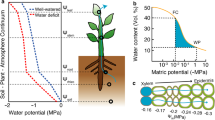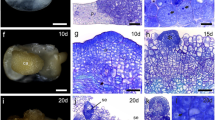Abstract
Microautoradiographs showed that [14C]sucrose taken up in the xylem of small and intermediate (longitudinal) vascular bundles of Zea mays leaf strips was quickly accumulated by vascular parenchyma cells abutting the vessels. The first sieve tubes to exhibit 14C-labeling during the [14C]sucrose experiments were thick-walled sieve tubes contiguous to the more heavily labeled vascular parenchyma cells. (These two cell types typically have numerous plasmodesmatal connections.) With increasing [14C]sucrose feeding periods, greater proportions of thick- and thin-walled sieve tubes became labeled, but few of the labeled thin-walled sieve tubes were associated with labeled companion cells. (Only the thin-walled sieve tubes are associated with companion cells.) When portions of leaf strips were exposed to 14CO2 for 5 min, the vascular parenchyma cells-regardless of their location in relation to the vessels or sieve tubes-were the most consistently labeled cells of small and intermediate bundles, and label (14C-photosynthate) appeared in a greater proportion of thin-walled sieve tubes than thick-walled sieve tubes. After a 5-min chase with 12CO2, the thin-walled sieve tubes were more heavily labeled than any other cell type of the leaf. After a 10-min chase with 12CO2, the thin-walled sieve tubes were even more heavily labeled. The companion cells generally were less heavily labeled than their associated thin-walled sieve tubes. Although all of the thick-walled sieve tubes were labeled in portions of leaf strips fed 14CO2 for 5 min and given a 10-min 12CO2 chase, only five of 72 vascular bundles below the 14CO2-exposed portions contained labeled thick-walled sieve tubes. Moreover, the few labeled thick-walledsieve tubes of the “transport region” always abutted 14C-labeled vascular parenchyma cells. The results of this study indicate that (1) the vascular parenchyma cells are able to retrieve at least sucrose from the vessels and transfer it to the thick-walled sieve tubes, (2) the thick-walled sieve tubes are not involved in long-distance transport, and (3) the thin-walled sieve tubes are capable themselves of accumulating sucrose and photosynthates from the apoplast, without the companion cells serving as intermediary cells.
Similar content being viewed by others
References
Altus, D.P., Canny, M.J. (1982) Loading of assimilates in wheat leaves. I. The specialization of vein types for separate activities. Aust. J. Plant Physiol. 9, 571–581
Barkas, W.H. (1963) Nuclear research emulsions. I. Techniques and theory. In: Pure and applied physics, vol. 15, Massey, H.S.W., ed. Academic Press, New York London
Botha, C.E.J., Evert, R.F., Cross, R.H.M., Marshall, D.J. (1982) Comparative anatomy of mature Themeda triandra Forsk. leaf blades — A correlated light and electron microscope study. J. S. Afr. Bot. 48, 311–328
Cartwright, S.C., Lush, W.M., Canny, M.J. (1977) A comparison of translocation of labelled assimilate by normal and lignified sieve elements in wheat leaves. Planta 134, 207–208
Colbert, J.T., Evert, R.F. (1982) Leaf vasculature in sugarcane (Saccharum officinarum L.). Planta 156, 136–151
Esau, K. (1977) Anatomy of seed plants, 2nd edn. Wiley, New York Santa Barbara London Sydney Toronto
Eschrich, W., Burchardt, R. (1982) Reactivation of phloem export in mature maize leaves after a dark period. Planta 155, 444–448
Evert, R.F. (1980) Vascular anatomy of angiospermous leaves, with special consideration of the maize leaf. Ber. Dtsch. Bot. Ges. 93, 43–55
Evert, R.F., Eschrich, W., Heyser, W. (1977a) Distribution and structure of the plasmodesmata in mesophyll and bundlesheath cells of Zea mays L. Planta 136, 77–89
Evert, R.F., Eschrich, W., Heyser, W. (1978) Leaf structure in relation to solute transport and phloem loading in Zea mays L. Planta 138, 279–294
Evert, R.F., Eschrich, W., Neuberger, D.S., Eichhorn, S.E. (1977b) Tubular extensions of the plasmalemma in leaf cells of Zea mays L. Planta 135, 203–205
Fritz, E. (1980) Microautoradiographic localization of assimilates in phloem: problems and new method. Ber. Dtsch. Bot. Ges. 93, 109–121
Giaquinta, R.T. (1980) Translocation of sucrose and oligosaccharides. In: The biochemistry of plants, vol. 3, pp. 271–320, Preiss, J., ed. Academic Press, New York London Sydney
Heyser, W. (1980) Phloem loading in the maize leaf. Ber. Dtsch. Bot. Ges. 93, 221–228
Heyser, W., Evert, R.F., Fritz, E., Eschrich, W. (1978) Sucrose in the free space of translocating maize leaf bundles. Plant Physiol. 62, 491–494
Heyser, W., Heyser, R., Eschrich, W., Fritz, E. (1977) The influence of externally supplied sucrose on phloem transport in the maize leaf strip. Planta 137, 145–151
Heyser, W., Heyser, R., Eschrich, W., Leonard, O.A., Rautenberg, M. (1976) The influence of externally applied organic substances on phloem transport in detached maize leaves. Planta 132, 269–277
Heyser, W., Leonard, O., Heyser, R., Fritz, E., Eschrich, W. (1975) The influence of light, darkness, and lack of CO2 on phloem translocation in detached maize leaves. Planta 122, 143–154
Hofstra, G., Nelson, C.D. (1969) The translocation of photosynthetically assimilated 14C in corn. Can. J. Bot. 47, 1435–1442
Kuo, J., O'Brien, T.P. (1974) Lignified sieve elements in the wheat leaf. Planta 117, 349–353
Lush, W.M. (1976) leaf structure and translocation of dry matter in a C3 and a C4 grass. Planta 130, 235–244
Miyake, H., Maeda, E. (1976) The fine structure of plastids in various tissues in the leaf blade of rice. Ann. Bot. (London) 40, 1131–1138
Pristupa, N.A. (1964) Redistribution of radioactive assimilates in the leaf tissues of cereals. Sov. Plant Physiol. 11, 31–36
Rogers, A.W. (1979) Techniques of autoradiography, 3rd edn. Elsevier/North-Holland, Amsterdam New York Oxford
Russell, S.H., Evert, R.F. (1982) Leaf vasculature in maize (Zea mays L.). (Abstr.) Bot. Soc. Am., Misc. Publ. No. 162, p. 23
Sanderson, J. (1981) Modified development to improve the performance of ARIO stripping emulsions for use with the more energetic isotopes. J. Micros. 124, 177–182
Sjolund, R.D., Shih, C.Y., Jensen, K.G. (1983) Freeze-fracture analysis of phloem structure in plant tissue cultures. III. P-protein, sieve area pores, and wounding. J. Ultrastruct. Res. 82, 198–211
Walsh, M.A. (1974) Late-formed metaphloem sieve-elements in Zea mays L. Planta 121, 17–25
Author information
Authors and Affiliations
Rights and permissions
About this article
Cite this article
Fritz, E., Evert, R.F. & Heyser, W. Microautoradiographic studies of phloem loading and transport in the leaf of Zea mays L.. Planta 159, 193–206 (1983). https://doi.org/10.1007/BF00397525
Received:
Accepted:
Issue Date:
DOI: https://doi.org/10.1007/BF00397525




